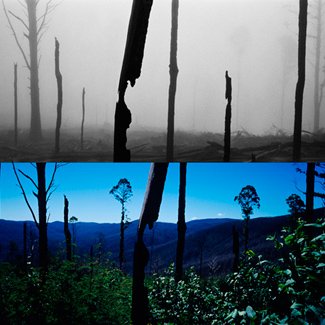Perfect storm led to Black Saturday bushfires

THE BLACK SATURDAY bushfires, which swept across Victoria in February 2009, were the most devastating in Australia’s recorded history. They caused 173 fatalities, destroyed more than 2100 homes and decimated a number of townships, including Marysville and Kinglake.
Knowledge of weather at the time demonstrated that particularly high daytime temperatures, strong surface winds and extremely dry conditions combined to produce the worst fire conditions on record.
Now, a new study, published in the Quarterly Journal of the Royal Meteorological Society, reveals that weather variations on more localised scales also exacerbated the Black Saturday fires.
Dramatic fire changes
The research, led by Dr Todd Lane and Chermelle Engel from the University of Melbourne, shows that knowledge of broad-scale weather conditions alone – such as temperature, humidity, wind speed and wind direction – cannot explain the dramatic fire changes that occurred over very short distances on Black Saturday.
“We wanted to better understand the dynamics of the weather on extreme fire days to help identify important atmospheric phenomena that could be useful for predicting and controlling fires,” Todd told Australian Geographic. “We also wanted to help prepare for future weather prediction capabilities that will become available with improvements in technology.”
The research suggests that localised ‘mesoscale phenomena’ – including cool changes, the interaction of airflow with nearby mountains and the structure of winds – combine with temperature and humidity variations to alter the shape, length, direction and speed of a fire front.
Bushfire forecasting models
To analyse these mesoscale phenomena, Todd and his team used a weather forecasting model to simulate the meteorological conditions that occurred during the Black Saturday fires, and compared the results to those from surface weather stations.
“The weather-forecasting model approximates the atmosphere on a grid and solves a series of mathematical equations to explain air flow at each point,” Todd says. “We solved the equations at more than 70 million grid points, using a supercomputer.”
This allowed for very accurate knowledge of weather conditions, and Todd hopes it will lead to better fire predictions. “Accurate knowledge of the timing and direction of the cool change is incredibly important for the safety of fire fighters on the ground,” he says. “This type of analysis can pinpoint the differences in fire danger at different locations associated with changes in the weather.”
Better bushfire prediction
Nicholas Gellie, fire scientist with the Bushfire Cooperative Research Centre in Melbourne, agrees this improves our understanding of fire behaviour, but he says this is only a starting point. “It’s fantastic research, but in order to change the fire-danger-rating system in Australia, you’re going to have to have a huge amount of commitment to training and to advancing further research,” he says.
For this new research to be benefit fire predictions, it would need to be part of a larger fire-management strategy, however.
“At the moment, we don’t even collect basic fire intelligence on the day of a fire,” he says. “What we need to do is create a conceptual framework that integrates knowledge about the atmosphere, the fire and fuels in the landscape, and then we’ve got to link new research, such as this study, with other fire-behaviour models so we can generate a more complete picture of what happens in a large fire.”
See before-and-after photos of the Black Saturday bushfires here
RELATED STORIES





